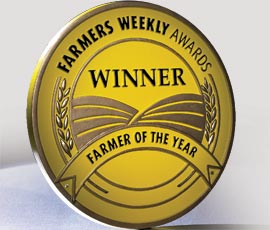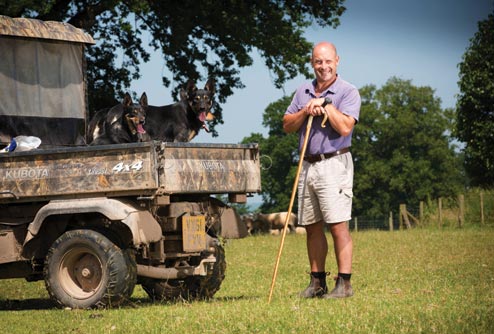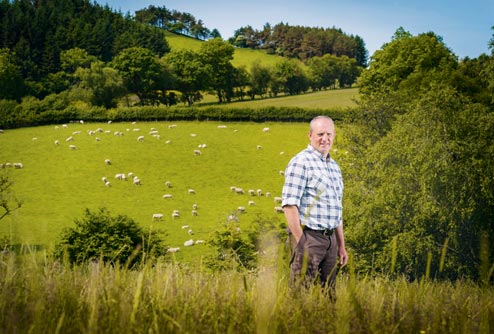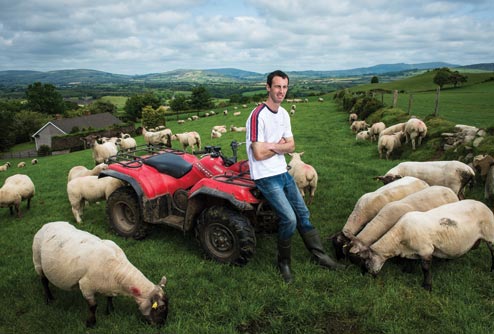2013 Farmers Weekly Sheep Farmer finalists revealed

Recording and selecting the best performing stock, while recognising the importance of grazed grass ensures all of this year’s Sheep Farmer of the Year finalists are breeding a system fit for the future, as Aly Balsom reports.
Edward Collins
Bearwood Farm, Leominster, Herefordshire

It may seem a bit extreme to label pedigree breeder Edward Collins a “data geek” but it’s recording enthusiasts like Edward who help secure the future of the commercial sheep sector.
“Records and genetics float my boat. My customer is relying on me to use all the technology and it’s my job to listen to what they want. I’m doing all the hard work for them,” he says.
A history of working with thoroughbreds, coupled with memories of working with a shepherd transfixed by data recording, helped pave the way for Edward’s dedication to data recording.
In 1998 Edward had the opportunity to come back to the family’s 324ha farm in Leominster. In the past the business had run a flock of North Country Mules but had moved into a share-farming agreement with an arable producer by the time Edward returned.
FARM FACTS
- 320 pedigree Lleyn females and 20 Blue Texels – all Signet recorded
- Sells breeding females and males to pedigree and commercial breeders
- Aim to finish lambs off grass
- Main flock tupped in October, housed middle of December, lambing inside on 1 March
- £53.61 a ewe profit or £36.90 a lamb
“There were a number of small fields less than 3ha in size that didn’t lend themselves to arable farming. These are down to permanent pasture and some are in ELS,” he explains.
“These fields couldn’t support large-scale commercial sheep production but were ideal for the more specialised pedigree market where small groups are required for individual recording.”
Consequently Edward introduced a flock of pedigree Lleyns, which fitted his requirement for easy-care sheep that could be managed by one person. Numbers now stand at 320 females and he has also recently introduced a small flock of 20 Blue Texels to make the most of this niche market. All stock are Signet recorded and MV accredited from the start. They are farmed over 41ha of permanent pasture.
Every animal is electronically tagged with a reader used to record at lambing and weighing. Data is then downloaded to recording software. Edward also goes beyond the requirement for Signet, weighing at eight weeks old, weaning, 21 weeks and 18 months.
He says the aim is to produce an animal that will meet the needs of the pedigree and commercial man. “With feed prices going up, farmers want an easy-care ewe that will convert grass into milk and a lamb that will finish off the green stuff,” he says.
“Most of my lambs will finish off grass and go as fat lambs by November. I want most gone by October as I need the ground for tupping.”
A selection of yearling rams and all stock rams are blood tested for scrapie and the myomax gene.
Most male lambs not destined for breeding are sold deadweight with most killing-out at R3L or better, weighing 19-20kg DW. Ninety percent of ewe lambs are sold for breeding through society sales or privately on farm, with 20-25 yearling rams also sold a year. Overall profits sit at £53.61 a ewe or £36.90 a lamb.
For Edward, embracing Facebook and Twitter, as well as running a website, has been key to successfully marketing his stock.
Meticulous recording allows strategic culling of any stock with problems. “Anything that’s a bad lamber, prolapses or is consistently lame is culled. One bad lambing and she’s out.
“People come back to me for ewe lambs because they lamb on their own and the only way to do this is through culling,” he says.
In fact through culling, picking up and treating lame sheep quickly and vaccination, Edward has reduced lameness from 15% to 4%. By selection he has also reduced lambing percent in the Lleyns from 230% to 190-200% helping him create a flock that’s easy for one man to manage.
Edward recognises the importance of communicating to the public and regularly hosts the village school at lambing time. He’s also held EBLEX events and set up a farm buying group for farmers in the area.
Keith Williams
Hendy, Llandrindod Wells, Powys

Hill farmer, Keith Williams cites quality plant and animal genetics as the crux to the success of his sheep enterprise at Hundred House, Powys.
For Keith, a focus on getting the most from genetics, while running a low-cost system is helping safeguard his business for a future without subsidies.
“Farming without subsidies is ultimately what it’s all about,” he says. “I want a low-cost system that makes the best use of genetics, while selling lambs into a premium market.
After being awarded a scholarship to study the topic of farming without subsidies in New Zealand, Keith introduced a number of key management changes to his flock of 800 ewes and 250 ewe lambs run across 167ha. Most notable was the introduction of a strict culling policy to breed a flock of easy-care ewes.
FARM FACTS
- 800 ewes, 250 ewe lambs and 30 sucklers
- Commercial flock of Welsh, Welsh Mules and Texel crosses, moving toward Lleyns
- 60 performance recorded pedigree Texels
- Lambs sold into Waitrose Welsh Lamb scheme
- Lambing 1 April
- £1.92/kg profit (beef and sheep)
“There is as much room for improvement by taking the bottom end out as there is from extending the front through genetics,” he says.
“In the past I only used to cull when stock got too old. Now I ear-notch any problem ewes, for example if they’re poor doers or have prolapsed. And female offspring will also be culled; no second chances.”
Rams are put in for six weeks and any barren ewes after this are culled, regardless of age.
Although traditionally Welsh, Welsh Mules and Texel crosses, Keith is increasingly moving towards Lleyns to breed an easier care ewe that will eventually lamb outside.
“We want to move away from the Texel cross ewe to the Lleyns to increase lambing percent, but still produce a R3L carcass to fit the Waitrose Welsh Lamb Scheme we sell into.”
Finished lambs have been sold to Waitrose since 2003, with 94% hitting specification with a target of 18kg DW at R3L.
The flock is closed on the female side with Lleyn rams selected on EBVs balancing for growth, muscle depth and maternal traits. “As I move to outside lambing, I don’t want triplets so I always look back three generations on the rams I buy and look for twins,” he explains.
Keith also runs a small flock of 60 performance recorded Texels which are run commercially. A small proportion are kept as terminal sires and some sold as yearlings.
Since 2010 the focus has been on improving muscle depth and his Texel flock is now in the top 5% for the breed. However, he believes he is not getting the market returns for selecting for this trait and consequently is undertaking a Nuffield Scholarship to look at grading.
Mr William’s experience as an HCC demonstration farm in 2008-11 coupled with lessons from New Zealand has also helped drive changes to grassland management. Sheep are grazed on rotation and generally receive about 1.6ha a day with an average rotation length of 15 days.
He believes grass quality has subsequently improved allowing him to generally finish off grass and avoid supplementing ewes. Cost of production sits at 117p/kg with a profit of £1.92/kg across beef and sheep.
Keith recognises wormer resistance as a challenge and has identified resistance to yellow drench on his farm. Consequently he only worms using faecal egg counting.
He is currently trying to set up a beef and sheep farmer benchmarking group with Farming Connect and is part of a farmer training group. He has also been involved in an agri-academy leadership scheme for the past 12 months.
Twenty-five percent of ground is in environmental schemes, with the farm belonging to the Farm and Wildlife Advisory Group (FWAG). In 2009 the business won the FWAG Cymru Silver Lapwing Award for Mid-Wales. “We’ve also been carbon footprinted and CO2/kg of meat was 80% of the average.”
Russell Scott
Newtownstewart, County Tyrone

Maximising the number of lambs reared for every ewe through careful selection has been the name of the game since Russell Scott returned home in 2005.
“We’re tied by land so the main aim is to maximise the performance of the flock, while keeping costs under control,” explains Russell who farms in partnership with his parents who work full time off the farm.
Russell admits when he first returned there were a number of areas that needed improving in the flock. Consequently, he saw careful recording and monitoring as essential to getting on top of issues.
FARM FACTS
- 330 ewes and 18 suckler cows
- Stratified breeding system to breed ewes to best suit variable land
- Aim for easy-to-manage, prolific ewe
- Lamb inside in April
- £78 profit a ewe and £37.77 profit a lamb (2010-11)
“In 2005 the flock wasn’t nearly as prolific as it is now with a lambing percentage of 175%. I moved on to the AFBI Hillsborough Management Recording System, which has allowed me to selectively cull.
“I try and breed a ewe that’s easier care in terms of reduced assistance at lambing, is milky, easily fleshed and prolific,” Russell says.
By monitoring ewe performance, he is able to cull ewes prone to producing singles and select for twins. Only twin or triplet ewe lambs are retained and he also only purchases tups that are either twins or triplets.
As a result lambing percentage has increased and is predicted to sit at 195% for this year because of a higher proportion of younger ewes in the flock.
In 2009 the business purchased a neighbouring farm, increasing the total acreage from 24ha with 75 ewes to 80ha with 330 breeding ewes.
The farm runs a closed flock on a stratified breeding system. Russell sees this as essential to breed different animals to fit with the farm terrain, which varies from quality arable ground to heather moorland at over 1,000ft.
The system starts with a flock of pure Perth Blackface ewes. The draft ewes from this flock are mated to Texel rams to breed Texel/Blackface ewes. These are in turn bred to the Suffolk ram with the progeny of this cross moved to the commercial flock and bred to Texel. Some of these ewe lambs are retained and crossed back to Suffolk.
“The Perth Blackface run on the hardest, marginal ground, with the Blackface cross Texels on the slightly better ground, still further away from the farm,” explains Russell.
Prompt treatment of ewes with sore feet and rotational grazing have helped reduce lameness and eliminate foot-rot, says Russell. The flock is also vaccinated for clostridial disease and toxoplasmosis.
Lambs are selected for slaughter from mid-June onwards, with the aim of producing a 21kg carcass grading E, U and R at fat class 3. Ram lambs are marketed through the local lamb group to Dunbia.
“I’ve also set up a market where surplus ewe lambs are sold to other sheep farmers at home at a premium,” he says.
There’s a big push to slaughter as many lambs as possible prior to weaning to take advantage of the higher kill-out percentage of milk-fed lambs and higher prices. Creep feed is also used on some lambs to get them away quickly and reduce pressure on the grazing platform.
“The flock has a high input, high output system and I feel the cost is justified if the number of lambs sold is high as well,” says Russell. For 2010-11 profit sat at £78 a ewe and £37.77 a lamb.
Grassland is regularly reseeded and soils tested, with ewes rotationally grazed on a paddock system.
In April 2012 Russell became one of six Focus Farms in Northern Ireland. Next year he also plans to do an Open Farm Sunday.
The home farm is part of the ESA Scheme that promoted the planting of hedgerows, wildlife corridors and heather moorland regeneration.
Sponsor’s message
 “This year’s Sheep Farmer of the Year finalists exemplify forward-thinking producers who are striving for the highest level of animal health, welfare and performance.”
“This year’s Sheep Farmer of the Year finalists exemplify forward-thinking producers who are striving for the highest level of animal health, welfare and performance.”
Joanne Worthington
MSD Animal Health
Find out more about the 2013 Farmers Weekly Awards
